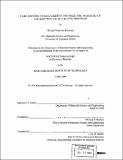| dc.contributor.advisor | Michael F. Rubner. | en_US |
| dc.contributor.author | Durstock, Michael, 1971- | en_US |
| dc.contributor.other | Massachusetts Institute of Technology. Dept. of Materials Science and Engineering. | en_US |
| dc.date.accessioned | 2009-06-30T18:40:46Z | |
| dc.date.available | 2009-06-30T18:40:46Z | |
| dc.date.copyright | 1999 | en_US |
| dc.date.issued | 1999 | en_US |
| dc.identifier.uri | http://hdl.handle.net/1721.1/46268 | |
| dc.description | Thesis (Ph.D.)--Massachusetts Institute of Technology, Dept. of Materials Science and Engineering, 1999. | en_US |
| dc.description | Includes bibliographical references (leaves 120-124). | en_US |
| dc.description.abstract | This thesis focuses on the use of a new sequential adsorption technique to deposit thin polyelectrolyte multilayer films. This involves alternately dipping a substrate into dilute aqueous solutions of a positively charged polyelectrolyte followed by a negatively charged polyelectrolyte, with a rinsing step in between. By repeating this process an arbitrary number of times, a thin film can be built up due to the electrostatic interaction between the two oppositely charged polyelectrolytes. This technique was used to create thin film electroluminescent devices based on poly(p-phenylene vinylene) (PPV) using a water soluble precursor to PPV and poly(acrylic acid) (PAA). The structure of such films has been shown to be highly dependent on the conditions of the dipping solutions. The pH of the solutions controls the degree of ionization of the PAA which influences the deposition process by affecting both the conformation of the PAA in solution as well as the charge density of the PAA on the surface. These films exhibited a light output of greater than 1000 cd/m 2 (about 10 times the brightness of a computer monitor), significantly higher than that typically reported for films of pure PPV. A time dependent charging process together with a reduction in the turn-on voltage with charging, and a non-rectifying device behavior, suggest an electrochemical mode of operation. In such a case, ions present in the film play an active role by modifying the electrical injection characteristics. More fundamental studies on the impedance and dielectric characteristics of sequentially adsorbed films were performed on layers of poly(allylamine hydrochloride) (PAH) with PAA as well as PAH with sulfonated polystyrene (SPS). This provided some insight into the level of ionic conductivity present in these films. Typically ionic conductivities were observed that ranged from about 10-12 S/cm at room temperature up to about 10-8 to 10-9 S/cm at 1 100°C. The apparent dielectric constant also increased to relatively large values at low frequencies implying the buildup of ions at the interface. The PAH/SPS system required much higher temperatures than the PAHIPAA system before any significant change in the electrical characteristics were observed suggesting that ionic motion is much more hindered in PAH/SPS films. | en_US |
| dc.description.statementofresponsibility | by Michael Frederick Durstock. | en_US |
| dc.format.extent | 124 leaves | en_US |
| dc.language.iso | eng | en_US |
| dc.publisher | Massachusetts Institute of Technology | en_US |
| dc.rights | M.I.T. theses are protected by
copyright. They may be viewed from this source for any purpose, but
reproduction or distribution in any format is prohibited without written
permission. See provided URL for inquiries about permission. | en_US |
| dc.rights.uri | http://dspace.mit.edu/handle/1721.1/7582 | en_US |
| dc.subject | Materials Science and Engineering. | en_US |
| dc.title | Light emitting characteristics and dielectric properties of polyelectrolyte multilayer thin films | en_US |
| dc.type | Thesis | en_US |
| dc.description.degree | Ph.D. | en_US |
| dc.contributor.department | Massachusetts Institute of Technology. Department of Materials Science and Engineering | |
| dc.identifier.oclc | 43896625 | en_US |
